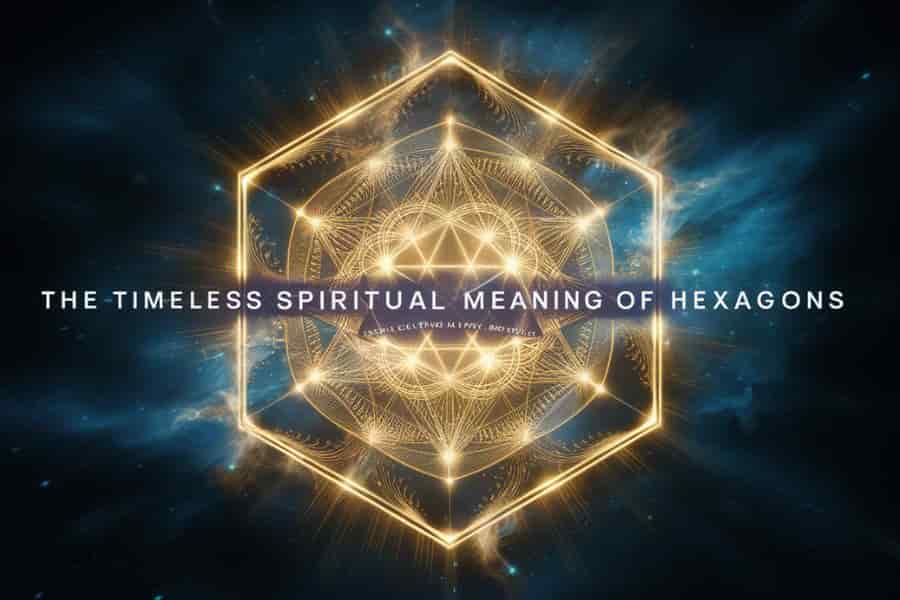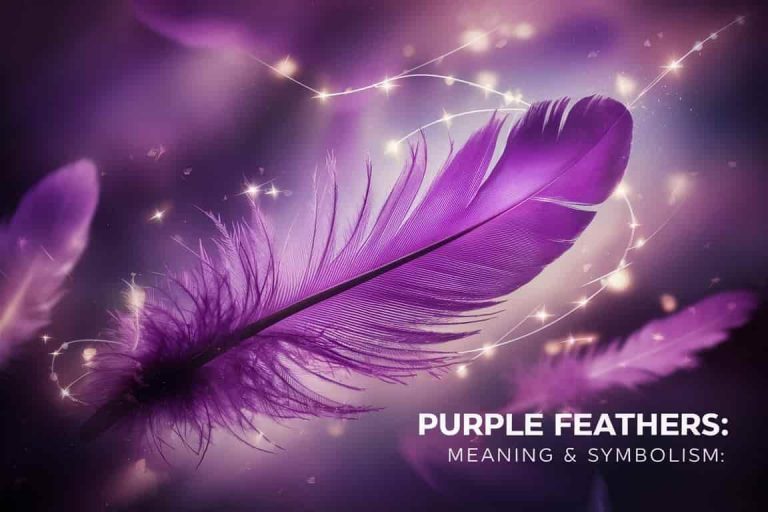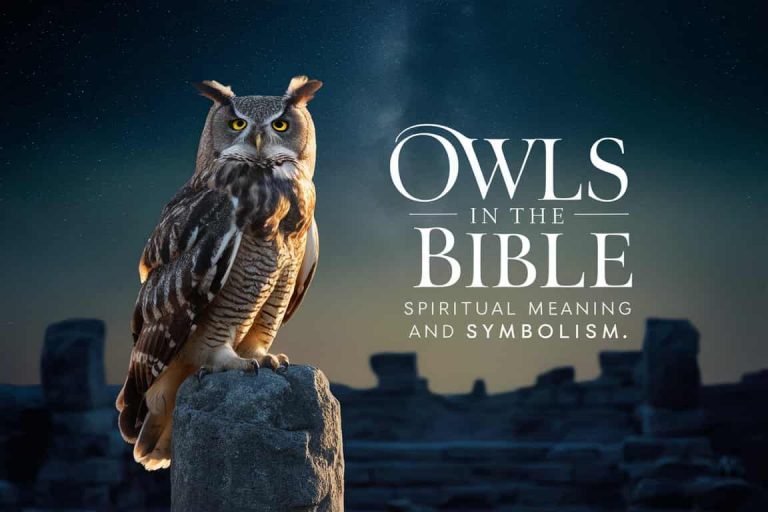The Timeless Spiritual Meaning of Hexagons Explained

The hexagon is a shape that appears frequently in nature and sacred geometry. It holds deep spiritual significance and symbolism across various traditions and cultures. The hexagon’s six equal sides and angles create a harmonious and balanced shape that reflects the interconnectedness of all things in the universe.
The Hexagon in Sacred Geometry
Sacred geometry is the belief that certain geometric shapes and patterns have inherent spiritual meaning and power. The hexagon is a key shape in sacred geometry, often appearing in religious symbols and artwork.
The Flower of Life and the Hexagon
The Flower of Life is a sacred geometric pattern consisting of overlapping circles that form a flower-like shape. At the center of the Flower of Life, a hexagon can be found. This hexagon represents the unity and balance that arises from the interconnectedness of all life.
The Flower of Life is said to contain the blueprints for all creation. The hexagon within it symbolizes the building blocks of life and the harmony that exists in the universe.
The Star of David and the Hexagon
The Star of David, also known as the Seal of Solomon, is a six-pointed star formed by two interlocking triangles. The hexagon is created by the space in the center of the star.
In Jewish tradition, the Star of David represents the connection between the divine and the earthly realms. The upward-pointing triangle symbolizes the spiritual world, while the downward-pointing triangle represents the physical world. The hexagon formed by their union represents the balance and harmony between these two realms.
The Star of David is also associated with protection and spiritual enlightenment. The hexagon at its center is believed to hold powerful energetic properties that can shield against negative influences and promote spiritual growth.
The Hexagon in Nature and the Universe
The hexagon is prevalent in the natural world, from the molecular level to the cosmic scale. Its presence in nature suggests a deeper significance and connection to the fundamental patterns of the universe.
Honeycomb Hexagons: A Divine Blueprint
Honeycombs are one of the most recognizable examples of hexagons in nature. Bees instinctively construct their hives using hexagonal cells, which provide the most efficient use of space and materials.
The hexagonal structure of honeycombs is not only practical but also holds spiritual symbolism. It represents the divine blueprint of creation, where efficiency, balance, and harmony are inherent in the design.
Bees and their hexagonal hives have long been associated with spiritual wisdom, community, and the interconnectedness of life. The hexagon in the honeycomb reminds us of the importance of working together in harmony and building structures that support the greater good.
Saturn’s Hexagonal Cloud Formation
One of the most stunning examples of hexagons in the universe is found on Saturn’s north pole. A massive hexagonal cloud formation, approximately 25,000 kilometers wide, swirls above the planet’s surface.
This cosmic hexagon is a testament to the fundamental patterns and shapes that exist in the universe. It reminds us of the grand design and the mysterious forces at work in the cosmos.
While scientists are still unraveling the secrets behind Saturn’s hexagon, its presence evokes a sense of awe and wonder at the perfection and symmetry found in the universe.
The Devil’s Postpile: Hexagonal Basalt Columns
In California’s Sierra Nevada mountains, a unique geological formation known as the Devil’s Postpile showcases the hexagon’s presence in the Earth’s crust. Towering columns of basalt rock, each with a hexagonal cross-section, rise from the ground like a natural cathedral.
The hexagonal shape of these basalt columns is a result of the rock’s cooling process. As the lava cooled and contracted, it cracked in a way that minimized the surface area, resulting in the formation of hexagonal pillars.
The Devil’s Postpile serves as a reminder of the inherent order and patterns that exist within the Earth. It demonstrates how nature’s processes can give rise to stunning geometric formations that hold both scientific and spiritual significance.
Enjoyed this? Here are more articles for you.
The Hexagon in World Religions and Spiritual Traditions
The hexagon appears in various world religions and spiritual practices. It often represents balance, harmony, and the interconnectedness of all things.
The Hexagon in Ancient Egypt
In ancient Egypt, the hexagon was used to symbolize spiritual attainment on mummified bodies. The six-pointed star, known as the Seal of Solomon, was often placed on the mummy’s chest to protect and guide the soul in the afterlife.
The hexagon was also associated with the goddess Hathor, who represented love, beauty, and fertility. Her sacred symbol was the six-pointed star, which was believed to hold powerful protective and transformative energies.
The Hexagon and Numerology
In numerology, the hexagon is closely associated with the number 6. This number represents balance, harmony, and the union of opposites.
The Number 6: Harmony, Balance, and Creation
The number 6 is considered a perfect number in numerology because it is the sum of its divisors (1 + 2 + 3 = 6). It represents the balance between the spiritual and material worlds, as well as the harmony between masculine and feminine energies.
In the Tarot, the sixth card of the Major Arcana is The Lovers, which depicts a man and a woman standing beneath a six-pointed star. This card symbolizes the union of opposites, the choice between sacred and profane love, and the integration of the conscious and unconscious minds.
The number 6 is also associated with creativity, nurturing, and responsibility. It encourages us to find balance in our lives and to create harmonious relationships with others.
The Hexagon in Alchemy and the Union of Opposites
In alchemy, the hexagon represents the union of opposites and the process of transformation. The six points of the hexagon symbolize the six stages of alchemical transformation: calcination, dissolution, separation, conjunction, fermentation, and distillation.
The hexagon is also associated with the “chemical wedding” of the king and queen, which represents the union of masculine and feminine energies. This union is believed to create a new, transformed substance that is greater than the sum of its parts.
In Jungian psychology, the hexagon represents the integration of the conscious and unconscious minds. It is a symbol of wholeness and the process of individuation, where the individual becomes aware of their true self and integrates all aspects of their personality.
The Seal of Solomon: Protection and Wisdom
The Seal of Solomon, a six-pointed star formed by two interlocking triangles, is a powerful symbol in many spiritual traditions. It is believed to offer protection against negative energies and to attract wisdom and understanding.
In Jewish tradition, the Seal of Solomon is associated with King Solomon, who was known for his wisdom and his ability to control demons. The six points of the star are said to represent the six days of creation, while the center represents the seventh day of rest.
In Islamic tradition, the Seal of Solomon is known as the Ring of Solomon and is believed to have been given to King Solomon by Allah. It granted him the power to control the jinn and to speak with animals.
The Seal of Solomon is also used in ceremonial magic and is believed to have the power to invoke and control spirits. It is often used in talismans and amulets to protect against evil and to attract positive energies.
The Hexagram: Unity and Duality
The hexagram, a six-pointed star formed by two overlapping triangles, is another powerful symbol associated with the hexagon. It represents the unity of opposites and the balance between the spiritual and material worlds.
In Hinduism, the hexagram is known as the Shatkona and represents the union of Shiva and Shakti, the masculine and feminine aspects of the divine. It is believed to hold powerful creative and transformative energies.
In Buddhism, the hexagram is associated with the Heart Sutra, one of the most important texts in Mahayana Buddhism. The six points of the star represent the six perfections: generosity, morality, patience, diligence, concentration, and wisdom.
The hexagram is also used in many Western esoteric traditions, such as the Hermetic Order of the Golden Dawn and Thelema. It is often associated with the planet Saturn and the element of earth, representing structure, stability, and manifestation.
The Hexagon in Religious Symbols and Iconography
The hexagon appears in many religious symbols and artwork across different traditions. It often represents the connection between the divine and earthly realms.
The Seal of Solomon: Wisdom and Protection
The Seal of Solomon, also known as the Star of David, is a six-pointed star formed by two interlocking triangles. The hexagon is created in the center of this symbol.
In Jewish and Islamic traditions, the Seal of Solomon is associated with King Solomon, who was known for his wisdom. It’s believed that this symbol was engraved on King Solomon’s signet ring, which granted him the power to command spirits and speak with animals.
The Seal of Solomon is used in talismans and amulets for protection against negative influences. The hexagon at its center is thought to hold powerful energetic properties that can ward off evil and attract positive energies.
The Hexagram: Unity of Opposites
The hexagram, a six-pointed star, is another significant symbol featuring the hexagon. It represents the unity of opposites and the balance between the spiritual and material worlds.
In Hinduism, the hexagram is called the Shatkona and symbolizes the union of Shiva and Shakti, the male and female aspects of the divine. It’s believed to hold powerful creative and transformative energies.
The hexagram is also used in Western esoteric traditions like the Hermetic Order of the Golden Dawn. It’s associated with the planet Saturn and the element of earth, representing structure, stability, and manifestation.
Incorporating the Hexagon into Spiritual Practices
The hexagon’s spiritual symbolism can be integrated into personal practices and sacred spaces. Here are some ways to work with the hexagon’s energy:
- Use hexagonal patterns or objects in meditation to focus on balance, harmony, and unity
- Incorporate hexagonal shapes into altar setups or sacred spaces to invite protective and transformative energies
- Create hexagon-based mandalas or artwork as a spiritual practice to connect with the divine and promote self-awareness
Hexagonal Meditation: Balancing the Chakras
The hexagon can be used in meditation to balance the seven main chakras, the energy centers along the spine. Each point of the hexagon can be visualized as a different chakra, with the center representing the heart chakra.
To perform a hexagon-based chakra meditation:
- Sit comfortably and focus on your breath
- Visualize a hexagon at each chakra, starting from the root and moving upward
- As you inhale, imagine energy flowing into each hexagon, bringing balance and harmony
- As you exhale, release any blockages or negative energy
- When you reach the crown chakra, visualize all the hexagons connecting and forming a unified whole
- Sit with this sense of integration and balance for a few moments before gently returning to your normal state of awareness
Regular practice of this meditation can help align and harmonize the chakras, promoting overall well-being and spiritual growth.
The Hexagon Compared to Other Spiritual Shapes
While the hexagon holds unique spiritual meanings, it’s worth comparing it to other significant geometric shapes:
- The circle represents wholeness, unity, and the eternal cycle of life
- The square symbolizes stability, groundedness, and the physical world
- The triangle signifies the connection between mind, body, and spirit, as well as the trinity found in many spiritual traditions
The hexagon combines elements of these shapes, embodying both the grounding qualities of the square and the uplifting nature of the triangle. Its six sides strike a balance between the simplicity of the circle and the complexity of shapes with more points.
Ultimately, the hexagon’s spiritual significance lies in its ability to integrate and harmonize seemingly opposing forces. It reminds us of the interconnectedness of all things and the potential for finding balance within ourselves and the universe.
The hexagon’s presence in nature, sacred geometry, and spiritual symbolism reveals its profound significance. From the smallest molecules to the grandest cosmic structures, this six-sided shape appears as a fundamental building block of creation.
Embracing the Hexagon’s Wisdom
By contemplating the hexagon’s meanings and integrating its symbolism into our lives, we can tap into its transformative power. The hexagon encourages us to seek balance, cultivate harmony, and recognize the divine order within the universe and ourselves.
As we encounter hexagons in the world around us, let us remember the deeper wisdom they hold. May the hexagon serve as a guiding symbol on our spiritual journeys, reminding us of our innate potential for growth, healing, and connection with the sacred.
The hexagon’s spiritual significance transcends cultures and traditions, inviting us to explore the mysteries of creation and the depths of our own being.
Sources:
Are Hexagons Sacred? Nature Would Say ‘Yes’ Inverse
Hexagons in Williamsburg Colonial Williamsburg Foundation
The Hexagon: An Indication of Order and Design in Nature NationsU
Hexagram Wikipedia






